046
047
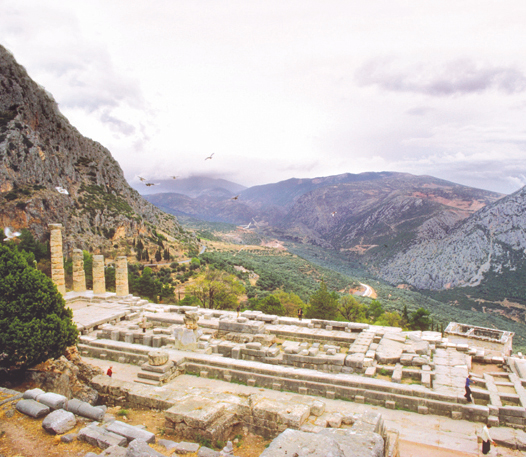
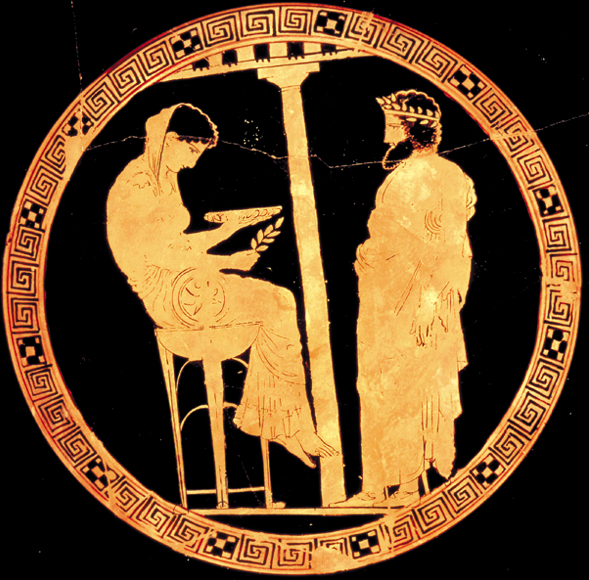
Archaeologists are good at recovering things left behind by the past, such as buildings, incense altars, tools and relief carvings. What they are not so good at recovering are the ideas, feelings and emotions—the innerness—of sentient ancient beings. It’s one thing to examine a temple’s holy of holies; it’s another thing to understand what went on there and what people experienced. Sometimes, however, there’s an exception to the rule.
Numerous classical authors report that natural phenomena played an essential part in one of their most sacred religious rituals: the oracle at Delphi. According to the geographer Strabo (c. 64 B.C.–25 A.D.), for example, “the seat of the oracle is a cavern hollowed down in the depths … from which arises pneuma [breath, vapor, gas] that inspires a divine state of possession” (Geography 9.3.5). Over the past five years, a team of researchers—a geologist, an archaeologist, a chemist and a toxicologist—has put that claim to the test, making it much more likely that we will actually understand 048what happened at Delphi.
When ancient Greeks and Romans had to make decisions, they consulted the gods—by drawing lots, casting dice, interpreting dreams and analyzing such signs as sneezes, thunderbolts and flying birds. But for matters of the utmost importance, they sought to hear the words of the gods in the mouths of oracles.a
Paradoxically, in male-dominated classical Greece the most influential voice, the Delphic oracle, belonged to a woman. The oracular temple was perched on the south slope of Mount Parnassus, surrounded by high cliffs, about 75 miles west of Athens. 049Getting to Delphi required either a long trek across the mountains or a sea voyage to the north shore of the Gulf of Corinth. However difficult the journey, thousands of visitors sought guidance from the holy woman, called the Pythia,bwho spoke on behalf of the gods.
The Pythia dealt less in visions of the future than in right choices: where to locate a new colony, when to attack an enemy, how to lift a curse, whom to choose as leader, what offering to make to which god. No kingdom, city or private person could afford to make critical decisions without consulting the Pythia. Thanks to her prestige, Delphi became the richest and most famous Hellenic sanctuary. The Greeks called it the omphalos, or “navel of the world.”
How could a mere mortal command such respect? The answer lies in the belief that Apollo—the god of revelation and inspiration—used the Pythia as his mouthpiece, taking possession of her during oracular sessions. The Pythia would fall into a trance, and the words she spoke were supposedly those of Apollo, delivered in a voice very unlike her normal tones.
Most scholars believe the Delphic oracle was established around the eighth century B.C., when founders of new colonies would consult the Pythia before setting out for the western Mediterranean, North Africa, Asia Minor or the Black Sea. The origins of the oracle are recounted in a story about a goatherd named Koretas, who pastured his flock on the slope of Mount Parnassus. Koretas noticed that when the goats grazed near a certain fissure in the 050mountainside, they began to bleat strangely. Approaching the fissure, he was filled with a prophetic spirit. Eventually, a woman—the first Pythia—was appointed to sit on a tripod over the cleft and give prophecies. Before she could mount the tripod, however, a goat had to be sacrificed to ensure that the day was propitious.
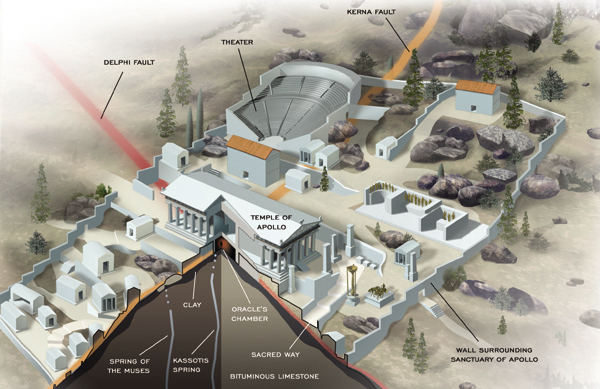
During the classical period, supplicants would line up at dawn to walk along the Sacred Way, a steep path snaking up through the sanctuary toward the Temple of Apollo. The priests and temple attendants determined the order of the queue, giving priority to state embassies and then working their way down through military commanders, athletes, poets and, last of all, mere heads of families concerned about a child or an investment. The supplicants filed past bronze statues, war monuments and treasure houses dedicated in the past by grateful visitors. It would have been late in the day by the time the ordinary men at the rear reached the terrace of the temple and viewed the famous inscriptions, “Know Thyself” and “Nothing in Excess.”
From here the way led up a ramp to a great colonnade of Doric columns, and then through a double door into the temple itself. Inside burned a constant pinewood fire tended by women of Delphi. The final approach to the oracle led downward into a sunken space below the level of the temple floor, where the visitor would be confronted by a gold statue of Apollo and the omphalos stone that marked the sacred spot. The Pythia sat in a recessed inner sanctum called the adyton, a Greek word meaning “not to be entered.” Standing outside the adyton, visitors would ask their questions and await the response.
Unlike itinerant prophets and omen-interpreters, the Pythia derived her power from the place—she could only prophesy while seated in the adyton within the Temple of Apollo. According to Strabo, the pneuma arose from a small opening (chasma ges) in the adyton: “Over the mouth [of the opening] a high tripod is set. Mounting this, the Pythia inhales the pneuma and then speaks prophecies in verse or in prose. The latter are versified by poets on duty in the temple” (Geography 9.3.5.).
Strabo was not the only ancient source to describe the adyton and the intoxicating gas. The second-century A.D. traveler Pausanias told of a spring in the temple’s adyton that made the Pythia prophetic. Also, 051in On the Obsolescence of the Oracles, the biographer Plutarch (c. 46–120 A.D.), who served as a priest of Apollo at Delphi, described an exhalation of vapor in the adyton that sent the Pythia into a trance.
Despite these testimonies, no serious scholar over the last 50 years has accepted the idea that the Pythia’s trance was caused by a gaseous emission.
Modern investigations began in the 1890s, when French archaeologists began to excavate the sanctuary at Delphi. They first moved the modern village of Kastri, household by household, from above the ancient sanctuary to the town of Delphi, west of the sanctuary. The French archaeologists uncovered the boundary wall of the ancient sanctuary, an entry gate, and the lower stretches of the Sacred Way. By 1893 they had reached the terrace of the Temple of Apollo—where they found that scarcely a stone remained in place above the floor. The columns had toppled, and the statuary had been carried off or destroyed. In the lower chamber, where the oracle once spoke, no trace of the ancient structure remained. Even the archaeologists’ attempts to reach bedrock were frustrated as water filled the excavated areas.
While the French team was excavating the temple, a young English scholar named A.P. Oppé published a report based on his visit to the site. Oppé proposed that the ancient sources had confused the fissure with a nearby gorge, and that the vapor was simply a fiction that had been passed down from source to source.1
In 1927, after a hiatus precipitated by World War I, a scholar named M.F. Courby published the French team’s final report of the temple excavations. He described the bedrock under the center of the temple as “fissured by the action of the waters”—suggesting that the ancient traditions of an opening in the rock may have been correct.2 By then, however, Oppé’s theory that the ancients simply misconstrued the facts had taken too strong a hold among scholars for the issue to be reconsidered. The final blow came in 1950: Pierre Amandry of the École Française d’Athènes stated definitively—or so it was widely believed—that exhalations of intoxicating gas could never have existed at Delphi. Only volcanic activity could produce such gas, Amandry (incorrectly) noted, and Delphi does not lie in a volcanic area.3 For almost half a century, debates about the geological origins of the oracle virtually ceased. c
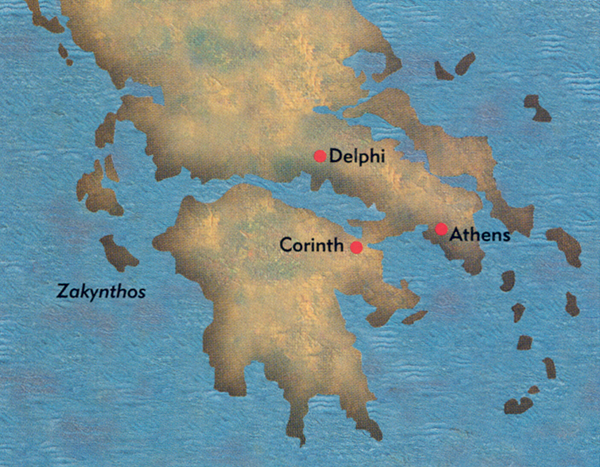
The first step toward a modern reassessment of the evidence was made in the 1980s by geologist (and co-author) Jelle Zeilinga de Boer, the senior member of our project in Delphi. De Boer was conducting surveys, under the auspices of the United Nations and the Greek government, to identify active fault lines. One area he studied was the south slope of Mount Parnassus, where he noted an exposed fault both east and west of the sanctuary of Apollo—though it could not be seen at the site of the temple, where it was covered by ancient construction and debris from rock slides. De Boer suspected that the fault did indeed run under the temple, but he gave the matter no more thought.
It was not until the summer of 1995 that Zeilinga de Boer encountered an archaeologist, co-author John Hale of the University of Louisville, who assured him, first, that he could not possibly have seen any such feature at Delphi and, second (after Zeilinga de Boer described the fault in detail), that this might be a discovery of major importance. We decided to continue investigations at Delphi, eventually adding a chemist (Jeff Chanton of Florida State University and the U.S. Geological Survey Magnetic Laboratory) and a toxicologist (Henry Spiller of the Kentucky Poison Center) to the team.
In 1996, with the support of Rozina Kolonia, the director of the Delphi Museum, we conducted a survey of the site and found that the sections of exposed fault on either side of the sanctuary were indeed part of the same fault—an active fault extending about 13 miles east-west along the southern flank of Mount Parnassus. We named this fault the Delphi Fault.
In subsequent seasons we identified a second fault, extending approximately southeast-northwest. This 052fault could be traced along a line of springs running through the center of the sanctuary. The highest spring, above the temple, is called the Kerna Spring; its water is currently channeled westward to modern Delphi. Further down the slope, though still above the temple, a mass of travertine (a kind of limestone) deposited by calcite-rich waters indicates another spring. There is also an elaborate channel for a spring built into the southern foundation wall of the temple itself. Although this spring is dry today, the early 20th-century French archaeologists found it difficult to reach bedrock within the sanctuary because their holes kept filling up with water. Down the slope below the temple, yet another spring emerges from a cleft in the bedrock near the Treasury of the Athenians.
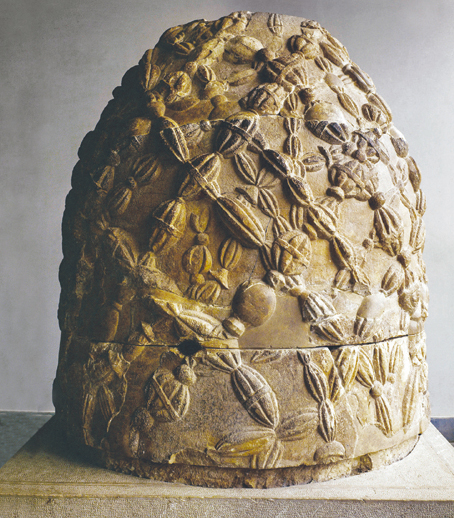
We have named this southeast-northwest fault the Kerna Fault, after its highest spring. In de Boer’s opinion, the Kerna Fault intersects the Delphi Fault at or near the site of the temple.
What the ancient authors described as a fissure (chasma ges) in the rock over which the Pythia sat was probably a small fracture extending up from the intersection of these two faults. Very likely, this is also what M.F. Courby, in his 1927 publication of the French team’s excavations, was describing when he wrote that the bedrock was “fissured by the action of the waters.”
Greek geologists had already identified the limestone under the temple as bituminous (oil-bearing), with a petrochemical content as high as 20 percent. These petrochemicals appeared to be a possible source of gases. But how exactly could they be released from the rock into the atmosphere?
The Delphi Fault is linked to one of Greece’s most geologically active features: the great rift, or graben, that today is filled by the waters of the Gulf of Corinth. This is a recent feature, geologically speaking, having formed roughly two million years ago. The rift continues to widen; as it does, motion occurs along faults and earthquakes are triggered. In 373 B.C., for example, earthquakes almost completely destroyed the Delphic temple on the north side of the gulf, as well as coastal towns on the south side.
As slippage occurs along the fault lines, adjacent rock masses are heated, vaporizing the lighter petrochemicals in the limestone and expelling gases upward along the face of the faults. Once faulting has opened such a pathway, gases continue to rise, although the volume would slowly decrease over time. We believe that this is exactly what happened at Delphi: The rock masses deep in the earth were heated, and they intermittently produced gases that rose up along the intersection of the two fault lines, eventually entering the adyton of the temple through one or more fissures over which the Pythia sat.
Exhalations of gases from bituminous limestone have been observed by geologists studying underwater faults in the Gulf of Mexico. There light hydrocarbon gases—methane, ethane and ethylene, all of them intoxicants—have been found bubbling up from the rock below. Closer to Delphi, similar exhalations 053were detected near the Isthmus of Corinth, as well as on the island of Zakynthos.
We decided to test the spring water at Delphi, along with samples of the travertine rock that the ancient springs had deposited on the retaining walls and slopes around the temple. If significant quantities of gases had been emitted with the spring water, traces of these gases might be found in the travertine deposits. The very presence of travertine rock, formed from dissolved calcites in warm spring water, is evidence that the springs along the Kerna Fault had their origin at deep levels.
The water and travertine from the sanctuary of Apollo, which were analyzed by Jeff Chanton, revealed traces of the light hydrocarbon gases found in the Isthmus of Corinth and on Zakynthos. Could this explain the Pythia’s state of intoxication in ancient times?
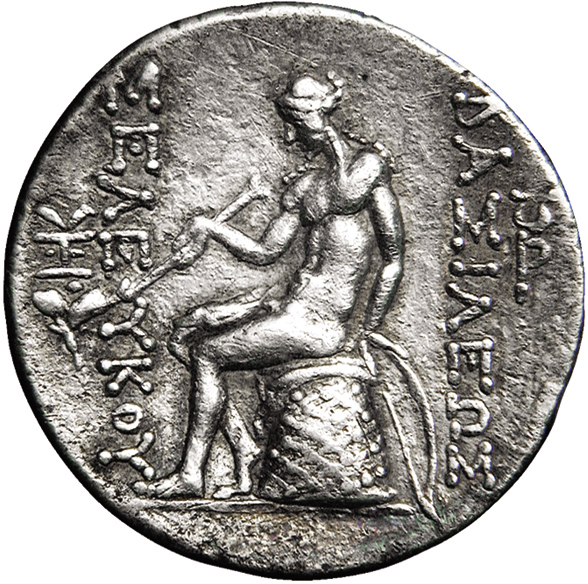
The ancient sources describe two distinct types of prophetic trance experienced by the Pythia. First, and more normally, she would lapse into benign semi-consciousness, during which she remained seated on the tripod, responding to questions—though in a strangely altered voice. According to Plutarch, once the Pythia recovered from this trance, she was in a composed and relaxed state, like a runner after a race. A second kind of trance involved a frenzied delirium characterized by wild movements of the limbs, harsh groaning and inarticulate cries. When the Pythia experienced this delirium, Plutarch reports, she died after only a few days—and a new Pythia took her place.
According to toxicologist Henry Spiller, both of these symptoms are associated with the inhalation of hydrocarbon gases. Spiller studies the effects of such inhalants on young people, known as “huffers,” who breathe in fumes from gas, glue, paint thinner and other substances because of their intoxicating properties. Perhaps the Pythia too was high on one of these hydrocarbon gases.
It may even be possible to identify the kind of gas. Plutarch—who, we recall, was a priest of Apollo at the Delphic sanctuary—noted that the intoxicating pneuma had a sweet smell, like expensive perfume. Of the hydrocarbon gases, only ethylene has a sweet smell—so ethylene was probably a component in the gaseous emission inhaled by the Pythia.
Now, there is a good deal of evidence concerning ethylene intoxication, particularly from the early 20th century. In laboratory tests involving human subjects, the pioneering anesthesiologist Isabella Herb and other scientists studied the effects of light doses of ethylene. Ethylene worked twice as fast as nitrous oxide (laughing gas) and achieved similar effects with only half the quantity. In high concentrations, ethylene produced complete unconsciousness; in low concentrations, it induced a trance state. Ultimately, ethylene’s use as a medical anesthetic was discontinued because of its combustibility: A spark from electrical equipment in the operating room could ignite the ethylene canister, causing it to explode.4
From the evidence of “huffers” and the experiments with ethylene, we know that subjects normally react to inhaling small quantities of these gases by entering a benign “out-of-body” trance. They can remain seated and answer questions, but their tone of voice and typical speech patterns are altered. Recovery takes place as soon as the subject is removed from exposure to the gas, and complete amnesia about the trance follows. In a minority of cases (about one in six) in the ethylene experiments, subjects experienced delirium, or a “bad trip.” Experimenters had to use restraints to hold down those undergoing this delirium, which was accompanied by groaning, shrieking and a thrashing of the arms and legs.
Unfortunately, no detailed accounts of the Pythia’s 058behavior survive from the golden age (seventh to fifth century B.C.) of the Delphic oracle. By the time Plutarch took office as priest of Apollo at Delphi, the oracle’s powers had significantly diminished. According to Plutarch, emissions of pneuma in the adyton were slight and unpredictable, leading to the decline of the oracle itself. He suggested that whatever produced the pneuma in the rock below the temple had become exhausted, or that the fissures in the rock had been blocked up in the 373 B.C. earthquake. The Delphic oracle never recovered its former prestige after this earthquake, even though the temple was rebuilt.
The diminished flow of gas may not have been the only reason for the decline of the institution. Plutarch opined that the pneuma was merely a trigger for the prophetic trance, and that the Pythia’s lifelong training and psychological preparation played the most important role in her spiritual possession. In a memorable simile, Plutarch compared Apollo to a musician, the Pythia to a lyre, and the pneuma to the musician’s uncanny ability to produce music by touching the instrument. Perhaps there were socio-cultural reasons for the decline of the institution, or perhaps, as the gaseous emissions became less powerful, devoting one’s life to the oracle became less attractive.
Whatever the reasons for the oracle’s demise, we can no longer dismiss ancient traditions concerning its origins and power. Strabo, Plutarch and the others have been rescued by science from a century of calumny.
Archaeologists are good at recovering things left behind by the past, such as buildings, incense altars, tools and relief carvings. What they are not so good at recovering are the ideas, feelings and emotions—the innerness—of sentient ancient beings. It’s one thing to examine a temple’s holy of holies; it’s another thing to understand what went on there and what people experienced. Sometimes, however, there’s an exception to the rule. Numerous classical authors report that natural phenomena played an essential part in one of their most sacred religious rituals: the oracle at Delphi. According to the geographer Strabo (c. […]
You have already read your free article for this month. Please join the BAS Library or become an All Access member of BAS to gain full access to this article and so much more.
Already a library member? Log in here.
Institution user? Log in with your IP address or Username
Footnotes
The oracle at Delphi was not the only ancient oracle, though it was the most powerful. Other Greek oracles were located at Epidaurus and in Asia Minor at Colophon and Didyma. Italy’s most famous oracle was at Cumae (near Naples), where a sibyl, or priestess, prophesied in a cavern; originally, the sibyl’s utterances were inscribed on palm leaves.
“Pythia” derives from the original name of the site, Pytho. Homer, for instance, refers to Apollo’s “shrine in Pytho” (Odyssey 8.94). The name “Delphi” came later.
However, this was not so among such Greek scholars as Spyridon Marinatos (1901–1974), the excavator of ancient Thera (modern Santorini), which was buried in a volcanic eruption around 1638 B.C. Marinatos argued that Delphi’s active geological history made it difficult to know what changes might have occurred over the past two millennia. He also made a report on an anemotrypa (wind hole) in the modern town of Delphi—a small cleft in the rock that emitted gas with a sulfurous smell. Scholars outside Greece ignored these ideas.
Endnotes
M.F. Courby, Topographie et architecture: la terasse du Temple: Fouilles de Delphes (1927), vol. 11, pp. 65–66.
See Isabella Herb, “Ethylene: Notes Taken from the Clinical Records,” in Anesthesia and Analgesia (December, 1923), pp. 210, 231–232; Herb, “Further Clinical Experiments with Ethylene-Oxygen Anesthesia,” Anesthesia and Analgesia (December, 1927), pp. 258–262; A.B. Luckhardt and J.B. Carter, “Physiologic Effects of Ethylene: A New Gas Anesthetic,” Journal of the American Medical Association, vol. 80 (January–June 1923), pp. 765–770.
